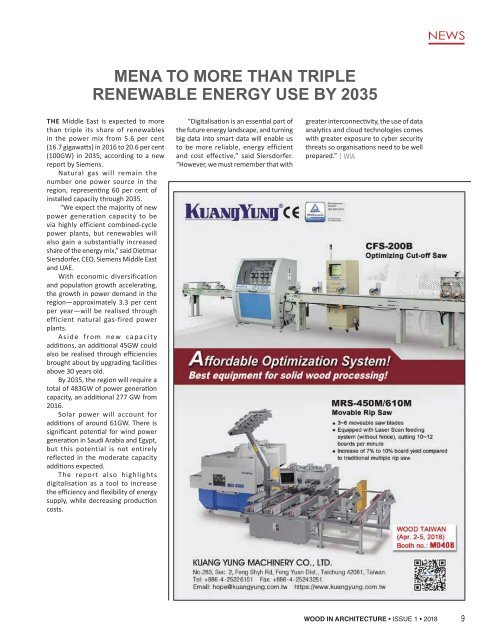Wood In Architecture Issue 1, 2018
First published in 2017, Wood in Architecture (WIA) is a bi-annual trade magazine devoted to the international timber construction sector. The newest addition to the Panels & Furniture Group of wood magazines, WIA features in-depth insights to the latest industry news, incredible projects and leading trade events. WIA is an advocate for timber as a material of choice for today’s built environment, and is the perfect source of inspiration for architects, builders, engineers and interior designers across the globe.
First published in 2017, Wood in Architecture (WIA) is a bi-annual trade magazine devoted to the international timber construction sector. The newest addition to the Panels & Furniture Group of wood magazines, WIA features in-depth insights to the latest industry news, incredible projects and leading trade events. WIA is an advocate for timber as a material of choice for today’s built environment, and is the perfect source of inspiration for architects, builders, engineers and interior designers across the globe.
Create successful ePaper yourself
Turn your PDF publications into a flip-book with our unique Google optimized e-Paper software.
NEWS<br />
MENA TO MORE THAN TRIPLE<br />
RENEWABLE ENERGY USE BY 2035<br />
Middle East is expected to more<br />
than triple its share of renewables<br />
in the power mix from 5.6 per cent<br />
(16.7 gigawas) in 2016 to 20.6 per cent<br />
(100GW) in 2035, according to a new<br />
report by Siemens.<br />
Natural gas will remain the<br />
number one power source in the<br />
region, represenng 60 per cent of<br />
installed capacity through 2035.<br />
“We expect the majority of new<br />
power generation capacity to be<br />
via highly efficient combined-cycle<br />
power plants, but renewables will<br />
also gain a substantially increased<br />
share of the energy mix,” said Dietmar<br />
Siersdorfer, CEO, Siemens Middle East<br />
and UAE.<br />
With economic diversification<br />
and populaon growth accelerang,<br />
the growth in power demand in the<br />
region—approximately 3.3 per cent<br />
per year—will be realised through<br />
efficient natural gas-fired power<br />
plants.<br />
Aside from new capacity<br />
addions, an addional 45GW could<br />
also be realised through eciencies<br />
brought about by upgrading facilies<br />
above 30 years old.<br />
By 2035, the region will require a<br />
total of 483GW of power generaon<br />
capacity, an addional 277 GW from<br />
2016.<br />
Solar power will account for<br />
addions of around 61GW. There is<br />
signicant potenal for wind power<br />
generaon in Saudi Arabia and Egypt,<br />
but this potential is not entirely<br />
reflected in the moderate capacity<br />
addions expected.<br />
The report also highlights<br />
digitalisation as a tool to increase<br />
the eciency and exibility of energy<br />
supply, while decreasing producon<br />
costs.<br />
“Digitalisaon is an essenal part of<br />
the future energy landscape, and turning<br />
big data into smart data will enable us<br />
to be more reliable, energy efficient<br />
and cost effective,” said Siersdorfer.<br />
“However, we must remember that with<br />
greater interconnecvity, the use of data<br />
analycs and cloud technologies comes<br />
with greater exposure to cyber security<br />
threats so organisaons need to be well<br />
prepared.” | WIA<br />
WOOD IN ARCHITECTURE • ISSUE 1 • <strong>2018</strong><br />
9


















